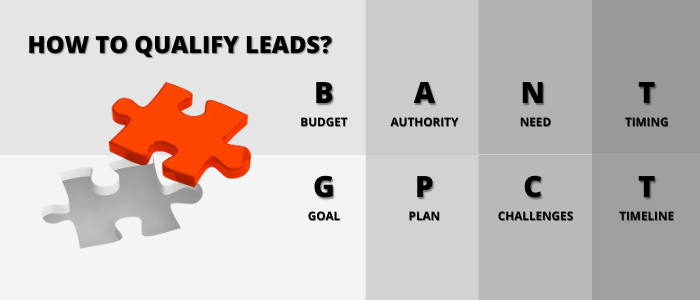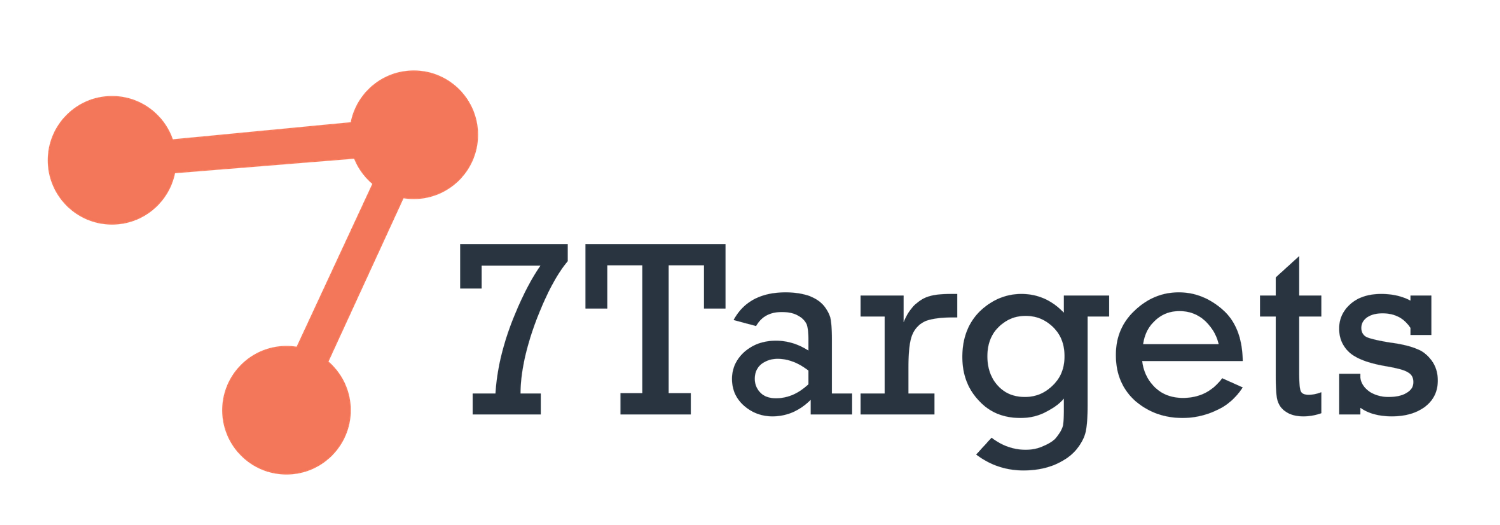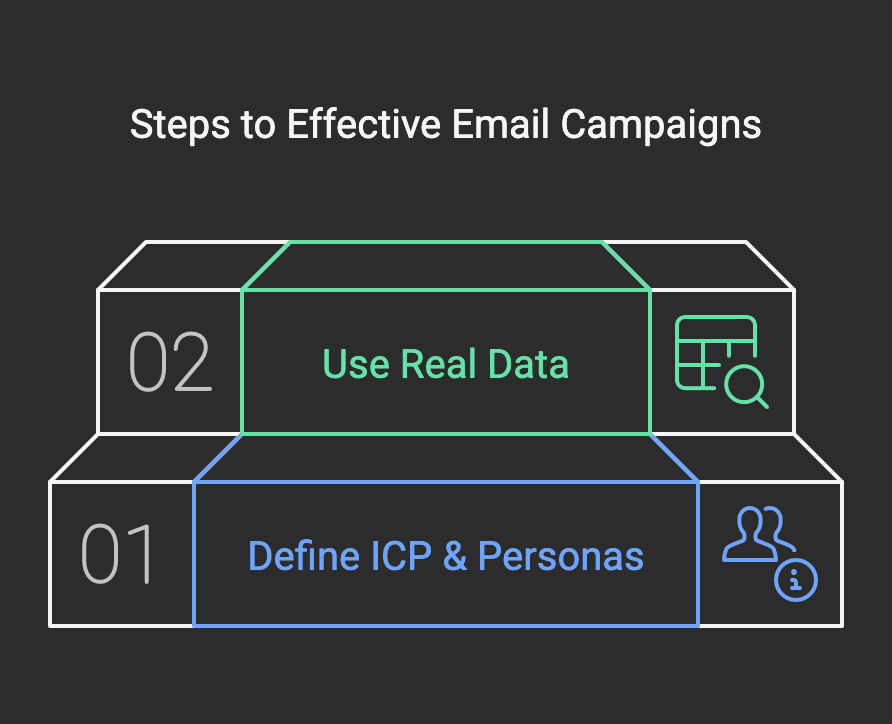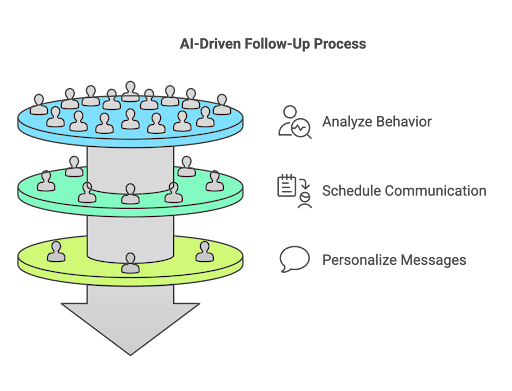What is GPCT? How to Qualify Leads using BANT and GPCT?


Closing a deal with a prospect that isn’t fit for your solution in terms of budget or planning or maybe timing will cost you your time, money, and energy without any returns.
Having a large number of leads that aren’t qualified systematically can be very chaotic. Nurturing these leads systematically pays off in the long run. In fact, disqualifying leads early in the cycle helps a lot in streamlining the follow-through processes.
Qualifying leads is not easy as it sounds. But once a lead is qualified, it helps you save your time, understand your lead’s current challenges, and also helps to personalize the communication experience effectively.
There are two qualification criteria in marketing for your leads to be qualified:
- BANT
- GPCT
Let’s understand each of them.
BANT
BANT stands for Budget, Authority, Need, and Timing. These are the four most basic aspects you should think about before going ahead and devoting your time to the lead. Let us find out how each of these aspects plays a vital role in decision making.
Budget
One of the most important aspects to be considered is, does the lead has the budget for your solution. There are several ways to guess this, but there is no accurate way to find it out for all leads. It’s worth analyzing parameters like company size, the title of the lead, the industry of the lead, number of years the company has been around and a few more such firmographics parameters to assume that ‘people with such titles often have this kind of budget at the start of the year’. After the initial few meetings, you will be able to get to a range for the budget. And hence you can decide whom to exclude out of your funnel and whom to include for the next step.
Authority
There are multiple people in the company at different positions to whom you can reach out to. Here are a few things to find out about the lead before setting up a meeting.
Who is the person you are reaching out to? Is it a person of authority? If someone likes your solution, is there a point in having a meeting with him/her without the authoritative person being present in the same meeting? Which other people are generally involved in approving a deal. How many meetings can you afford? What’s the impact of this time spent on customer acquisition cost.
If you directly reach out to a person of authority in parallel with the users of your solution, it can save an incredible amount of heartburn later in the sales cycle.
LinkedIn is one of the best places where you get the designation of people. This helps in targeting those who fit your ideal customer profile definition.
Need
Often you may reach out to someone who is having authority and has enough budget but does not have the need for your solution. This does not get you a conversion. If a lead doesn’t have a need then, creating a need or creating a market is generally very difficult. Large companies do have such capabilities, but smaller companies should not attempt to create a new segment without serious investor backing.
In outbound marketing, since nobody can predict whether a lead has a need, the best way is to have a longer term nurturing program so that you don’t try to “time the lead”.
Inbound marketing is magical in that sense, where a lead visits google to search for something when they need it. And that makes inbound conversion rates higher than outbound conversion rates.
Timing
Does the lead have the need Now? Timing is such an important factor that a study was done by Bill Gross on what makes a startup company successful. He had 5 parameters. Funding, business model, people/team, idea or timing? Well, his conclusion was the Timing of that company; the timing of that offering in the market attributes to 40% weight for that company’s success. If you are not getting your timing right, you might never land your lead as a customer. Your best bet is to nurture leads over the entire year, and sometimes over multiple years. So that whenever the need arises, they probably can recall your solution.
Watch how 7Targets aid to increase sales using AI sales assistant.
If your lead satisfies all the four aspects i.e. Budget, Authority, Need, and Timing then you are said to have a BANT qualified lead!
GPCT
The second way to measure leads is by GPCT.
GPCT stands for Goal, Plan, Challenges, and Timeline.
This method is better suited when you know your ICP - Ideal Customer Profile - really well. 3 important aspects of ICP are:
- Title of the target persona
- KPIs that this person is measured by
- Size of company
If you know that it’s a startup, then you have a general idea of what may be their goals in the first two years, given the budget challenges.
If you know it’s a funded startup, then chances are they have completed a pilot and they are looking to spend serious money within a short time and scale the company with aggressive goals and timelines.
If a company is greater than 2 years and less than 4 years, you can probably guess that they have setup their initial couple of sales guys and now want to seriously look at marketing the success stories for faster growth. Their budgets will be placed accordingly.
Once you can more or less ‘guess’ their goals and challenges, you can create a better message for engaging them. And you cannot guess a companies goals unless you understand your ICP deeply.
Assuming that you know your ICP well, you will know about your leads Goals, what is their tentative plan to achieve them, what are the Challenges they generally face. And you will get it right for about 10% to 30% leads. That’s all we need to get an initial response.
Here are some of the questions you may want to ask yourself as you collect data from prospects to find your sweet spot with respect to GPCT.
Goals
In general, what goals does management like to see?
What kind of people and expertise would an organization need to reach those goals?
What are the numbers that mediocre teams generally hit successfully, and what number can you achieve for them?
Plan
Links to plan templates for your sweet spot customer profiles. Measure traffic on this page via Google Analytics will show if anyone is engaging and interesting in checking out your plans and how you propose to hit some goals.
You can mention your resources with certain experts in the template plans so that the prospect starts thinking of either hiring an expert or directly getting one from you.
A few customer names WITHIN the same customer profile where this plan has worked will go a long way in getting higher response rates.
Challenges
What are the key challenges people face and why? Showing a deeper understanding of the problem enhances the chances of someone trying you out.
Impact statements: If a challenge is not overcome in a planned way, what impact does a missed goal have on the organization? Articulating that with some high-level numbers can help provide clarity and can be used to create urgency as well. Why now? Why should someone respond to you and not next month? This part of the message is best done using Impact statements.
Don’t leave it to the reader to think about org impacts. Spell it out there in black and white, even if it is not 100% perfect.
Timeline
And if they have a plan then what is the timeline of their plan?
Management and investors love timelines. Incorporating shorting 1 month, 3 month timelines of initial engagement is equally important while showcasing longer term goals.
This shorter term view helps to gain initial traction and allows customers to get out of the engagement if initial traction is not seen. This is key to allowing someone to try you out without long term commitment.
Once you get more facetime with the prospect, of course, you have a much more richer medium to make a better impact and ask more questions along deeper GPCT to qualify the lead. At the beginning of the funnel, it’s important to provide the GPCT clarity in initial lead nurturing messages as well.
Knowing all this about your lead helps you to figure out the next steps. Better alignment of the message is key to TOFU success.
I would suggest that you can use either BANT or GPCT, but you should be very specific and clear about your buyer’s persona and this will help you to qualify your leads accordingly.






Comments